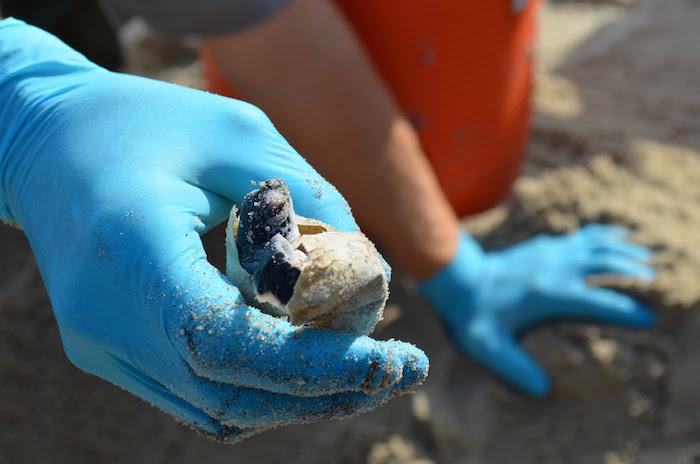
Nearly 60 green sea turtle hatchlings survived their mother being run over on the beach at Cape Hatteras National Seashore/NPS
Scraps of egg shells told the story: though their mother was killed when a vehicle drove over her on a Cape Hatteras National Seashore beach, some of the 172 eggs taken from the green sea turtle and placed in a sandy nest survived the ordeal to incubate, hatch, and make it into the Atlantic Ocean.
Seashore staff were able to recover nearly 200 Ping Pong-sized eggs from the female shortly after her crushed body was discovered on August 21. While the eggs were buried on the beach, the odds against their hatching were long. Eggs reburied following similar circumstances in the past had hatched, but sea turtles in North Carolina start nesting in May, and it can take their eggs about two months to hatch, depending on the temperature of the sand, according to the North Carolina Wildlife Resources Commission.
The prospect of a robust hurricane season -- 12-17 named tropical storms, five-eight of which were expected to turn into hurricanes, were predicted -- could also endanger the nest. Indeed, Cape Hatteras on North Carolina's Outer Banks weathered two storms before some of the eggs hatched -- Tropical Storm Hermine and Hurricane Matthew.
"On October 24, 2016, day 63 of incubation, a depression (uniform dimple over top of the nest site) formed, giving staff 100 percent confirmation that some of the 172 eggs were in fact viable. Against all odds the nest started to hatch on October 26, 2016, day 65 of incubation," noted William Thompson, the seashore's lead biological science technician for its Hatteras District. "The hatch event observed is known as a trickle, this is when the a nest only hatches out a few sea turtles at time, unlike a 'boil,' when they all hatch at once. For the next seven days, staff confirmed 29 hatchlings had emerged and made it the ocean on their own by observing the hatchling tracks they left behind before the start of their new journey towards the Gulf Stream."
On November 3, seashore staff excavated the nest to see if there were any more viable hatchlings.
"Upon digging the nest site up, we discovered a total of 113 unhatched eggs (88 undeveloped embryos, four early stage embryos, two mid-stage embryos, 13 late-stage embryos, five dead pipped, and one predated egg by ghost crab), 59 eggshells, and 26 live hatchlings that were released that evening," Mr. Thompson added. "With this information we determined that 33 hatchlings made it the ocean on their own and a total of 59 hatchlings hatched from the 172 eggs that were relocated.
"... Due to the nest's success, we now know that the female's genetics remain in the system and, hopefully, one day one of these hatchlings will make it back to our beaches to complete the cycle its mother never had the chance to do."



Add comment